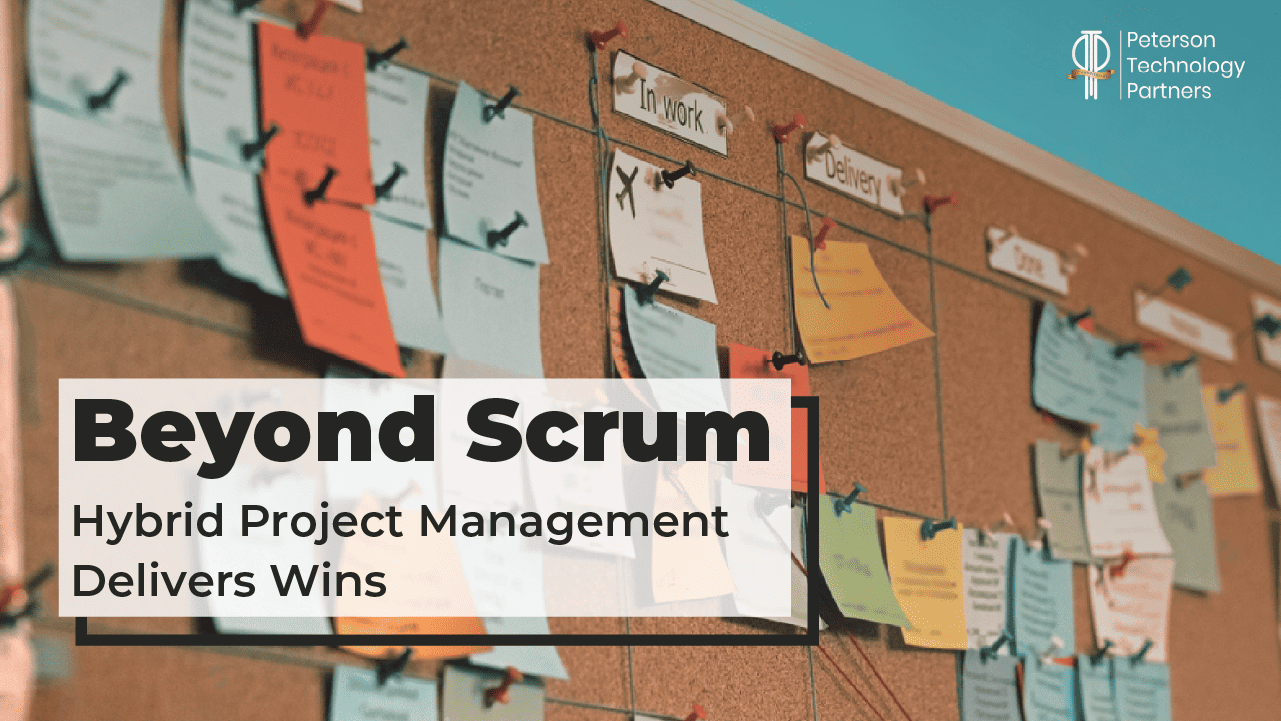If you take comfort in the thought that nobody’s perfect, you might not want to know that a 100% project completion win rate is not only possible, but something around 2.5% of companies have already achieved. But if you, on the other hand, take comfort in knowing what’s possible so that you can achieve it yourself, you’re already asking: How are they doing that?
Hybrid project management is one of the ways. Defined as an approach that seeks to combine attributes of other known project management methodologies (e.g., Scrum), hybrid project management is favored by organizations that tend to run very robust projects, or have projects with lots of ‘moving parts’ to keep track of. It facilitates a holistic perspective whereby the larger organization’s goals can be easily kept in view and not obscured by pressing daily priorities. How else can hybrid PM processes and ways of thinking help your teams?
-
Greater flexibility
Hybrid project management lets a project manager combine the most powerful aspects of other PM approaches like waterfall, agile, and Scrum, all without necessarily inducing their respective drawbacks into the process. As far as what aspects you might want to import from each methodology, and which project phases you’ll choose to hybridize, the best part of hybrid PM is that those questions are largely left up to you. The correct answers are, simply put, the ones that work the best for your particular team or projects.
Let’s look at an example. Suppose your teams respond well to the strong, structured initial project planning phases that are characteristic of the waterfall style, but don’t continue to do well with waterfall after development commences. That lets you know that initial project planning and groundwork phases should likely stay done according to the waterfall approach. Additionally, if your teams happen to struggle with scope creep, using waterfall during the planning phases can help establish a guardrail. By mandating that project requirements be aligned and agreed to prior to development, you can save a lot of time and stress later.
As the Project Management Institute memorably clarifies, “If there is potential misunderstanding between the customer and contractor on the work scope, the processes that will be applied, the deliverables and milestones of the project, then clarification of these issues once the project is underway, even if achieved ‘peacefully’ and without antagonizing the customer, will often result in scope creep.” Using the hybrid PM style in this way, it becomes possible to fend off scope creep while preserving mission-critical relationships with both internal and external customers.
[RELATED: DataOps can bring certainty to uncertain data.]
-
Easier experimentation
It’s important to note that within a hybrid project management model you’re not married to waterfall as a starting point (or at any other time); you can, and should, incorporate other PM doctrines, as and when you note that they’ll do the most good for teams. Of course, now there are questions: Which doctrines? When to implement them? Maybe you only have experience in agile; can you still implement a hybrid model? Hybrid project management is also an excellent tool to discover those and many more answers – it’s almost like a ‘free trial’ of different PM approaches and working cultures.
Project managers dabbling in hybrid approaches have the ability to introduce new concepts in a low-stakes format, more palatable to even the most reluctant of teams. If you’re contemplating a switch in formats, but aren’t sure if you’ll receive enough buy-in to switch over to your PM methodology of choice, you’ll find it’s often easier to get everyone aligned and working on a hybrid project or two, and then assess. To use our example from above, if your teams have reservations about how flexible the agile approach might be in practice, going hybrid lets them create and implement the plan that will serve as a guiding light, while letting them benefit from the increased flexibility of agile, knowing that the initial agreed-upon plan won’t let anyone stray too far off the objective.
Another aspect that allows for easy tests and trials of hybrid PM practices is familiarity. Since your team members, no matter their backgrounds, are likely familiar with Scrum or waterfall practices at the outset, there can be a lot less to do in terms of initial setup and bringing everyone up to speed on the new processes. As David Robbins, the founder and CEO of hybrid PM tool Binfire, identifies, “…If people are trained in both Agile and Waterfall there is less to learn. The challenge is to get into the mindset of having [sprints] for short-term delivery and organizing for long-term product success.”
[RELATED: Does the 4-day work week work for everybody?]
-
Deliver at modern speed
Once you’ve run some successful small-scale projects using the hybrid methodology of your choice and creation, you’ll start to realize more value from your tech teams – including that most crucial of modern metrics, speed. While the hypothetical team from our ongoing example above will still spend time in scoping and planning their projects waterfall style, the time they’re going to save in development and successive phases, given their project plan to serve as a guardrail against scope creep, will be significant. Future releases and fixes can now debut much faster.
But since we’re talking about results, let’s look at some incredible achievements that real companies accomplished the hybrid way:
- Online publisher Atypon began a massive data migration project, intended for their new website. They started off working in waterfall style but later switched to agile in pursuit of better flexibility. Using hybrid PM strategies, Atypon’s teams increased not only flexibility but speed as well, delivering their migration solution in just 9 months. Quite the savings when compared with the 12-month timeline in the team’s original estimate from the planning phase!
- Freelancer startup Xplace shook up their teams’ work style, moving from a strictly waterfall PM approach to a hybrid model. Teams subsequently reported up to 25% faster product delivery times — as well as 18% fewer bugs! Since the new methodology, despite its speed boosts, didn’t require that teams compromise on sprint task completion (as would their previous waterfall approach), it was no trouble for teams to take time with the finishing touches.
Being able to pick and choose from among project management styles, and to combine them with the legacy processes that best support your teams’ output is what makes hybrid project management great. It can’t be guaranteed that by adopting a hybrid approach you’ll instantly join that rarified 2.5% of orgs that have 100% project win rates. However, if you are willing to experiment, you will discover a new ability to blend PM methodologies until the way your teams work becomes the best, most effective way for your organization to deliver wins.





